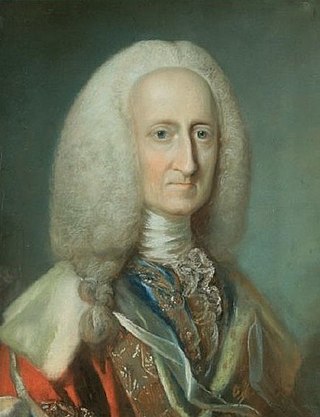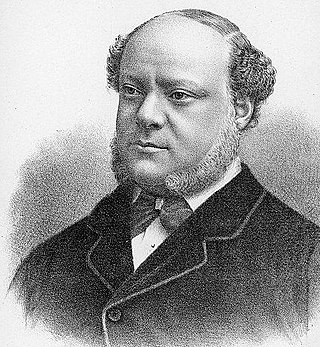
(Rehearsal of an opera, by Marco Ricci, ca. 1709).
Catherine Tofts or Katherine Tofts (died 1756) was the first English singer who sang Italian opera in England. [1]

Catherine Tofts or Katherine Tofts (died 1756) was the first English singer who sang Italian opera in England. [1]
About 1704, the competition between Tofts and Margherita de l'Épine was in earnest. Perhaps to illustrate the famed rivalry, Marco Ricci painted L'Épine with her back to Tofts, in the composition Rehearsal of an opera (c.1709) . [2]
Jonathon Swift has a short poem about Mrs Tofts in his "works" which talks of her beauty. It is thought however that the verse was written by Alexander Pope. [3]
Tofts quit the stage in 1709 and married Joseph Smith, English consul at Venice. [1] They had a son but he died when still a child and Catherine became mentally ill. She died in 1756 and her husband married again the following year. [4]

Johann Christoph Pepusch, also known as John Christopher Pepusch and Dr Pepusch, was a German-born composer who spent most of his working life in England. He was born in Berlin, son of a vicar, and was married to Margherita de l'Epine who also performed in some of his theatrical productions.
This article contains information about the literary events and publications of 1707.

George Lyttelton, 1st Baron Lyttelton,, known between 1751 and 1756 as Sir George Lyttelton, 5th Baronet, was a British statesman. As an author himself, he was also a supporter of other writers and as a patron of the arts made an important contribution to the development of 18th-century landscape design.

Allen Bathurst, 1st Earl Bathurst,, of Bathurst in the County of Sussex, known as The Lord Bathurst from 1712 to 1772, was a British Tory politician. Bathurst sat in the English and British House of Commons from 1705 until 1712 and then in the British House of Lords until his death in 1775, after being raised to the peerage as Baron Bathurst.

Elizabeth Elstob, the "Saxon Nymph", was a pioneering scholar of Anglo-Saxon. She was the first person to publish a grammar of Old English written in modern English.

Alberto Randegger was an Italian-born composer, conductor and singing teacher, best known for promoting opera and new works of British music in England during the Victorian era and for his widely used textbook on singing technique. His compositions included ballets, masses and other church music, operas and numerous other vocal pieces. He also edited several collections of vocal music.

Elizabeth Lydia Rosabelle, Lady Clifford, as known as Mrs Henry de la Pasture, was an English novelist, dramatist and children's writer. Her children's novel The Unlucky Family has been called a classic of its genre.

Joseph Smith, often known as Consul Smith, was the British consul at Venice from 1744 to 1760. He was a patron of artists, most notably Canaletto, a collector and connoisseur, banker to the British community at Venice, and a major draw on the British Grand Tour. His collection of drawings was bought for George III of Great Britain and forms a nucleus of the Royal Collection of drawings in the Print Room at Windsor Castle.

Joseph Wilcocks was an English churchman, bishop of Gloucester, and bishop of Rochester and dean of Westminster.

Margherita de L'Épine was an Italian soprano of the Baroque era. She was among the most popular and successful of London's female singers in the years just before and after Italian opera became introduced to the city. Today, she is best remembered for her performances in the operas of George Frideric Handel, and her longstanding association with the composer Johann Pepusch, whom it seems she married around 1718.
Thomas Clayton (1673–1725) was an English violinist and composer, and a member of The King's Musick at the court of William III. His is said to be the first to acclimatise legitimate opera in England.
Maria Gallia, was a British soprano.
Johann Jakob Greber was a German Baroque composer and musician. His first name sometimes appeared in its Italianized version, Giacomo, especially during the years he spent in London. Greber composed solo cantatas, sonatas, and stage works, including the opera Gli amori di Ergasto which opened London's Queen's Theatre in 1705. He died in Mannheim, where for many years he was Kapellmeister of the court orchestra of Charles III Philip, Elector Palatine.

Anthony Henley (1667–1711), of The Grange, Northington, Hampshire, was an English Whig politician who sat in the English and British House of Commons between 1698 and 1711. He was noted as a wit.

Joseph Smith (1670–1756) was an English churchman and academic, Provost of The Queen's College, Oxford, from 1730.

Thomyris, Queen of Scythia was a pasticcio opera based on a libretto by Peter Anthony Motteux. It was produced by John James Heidegger at the Theatre Royal, Drury Lane in April 1707. Motteux’s prologue directly referenced Anne, Queen of Great Britain, under whose reign female stage protagonists were very popular.

Hydaspes is an opera by Francesco Mancini with a libretto by Giovanni Pietro Candi. It was first performed at the King's Theater in the Haymarket, London, on 23 March 1710. It was the second opera in England to be sung entirely in Italian, after Almahide, and was an early London success for the famous castrato Nicolò Grimaldi in the title role.
Camilla was an opera first performed at Drury Lane in London on 30 April 1706. The libretto was based on Il Trionfo di Camilla, regina de' Volsci by Silvio Stampiglia, translated into English verse by Owen Swiny, Peter Motteux, or others. Authorship of the music for the original is attributed variously to Giovanni Bononcini and to his brother Marc Antonio. Music for the London version was adapted by Nicola Haym. The opera was the first to be sung in a mixture of English and Italian, and it was one of the first London operas in which the castrato Nicolò Grimaldi performed.

Pyrrhus and Demetrius was a 1708 adaptation for the London stage of the 1694 opera Il Pirro e Demetrio by Alessandro Scarlatti with a libretto by Adriano Morselli, first performed at the it:Teatro San Bartolomeo.
Maria Manina, later Maria Fletcher later Maria Seedo/Sydow, was an Italian opera and concert singer. She came to notice in London in 1712 and was last recorded in Potsdam in 1736.